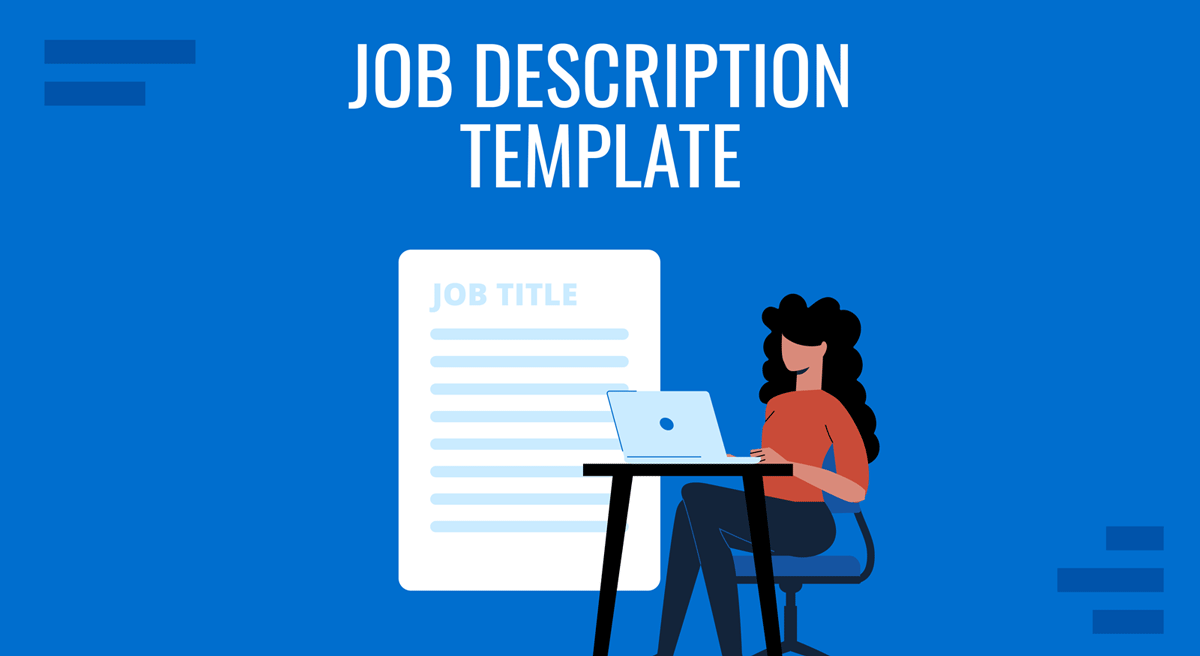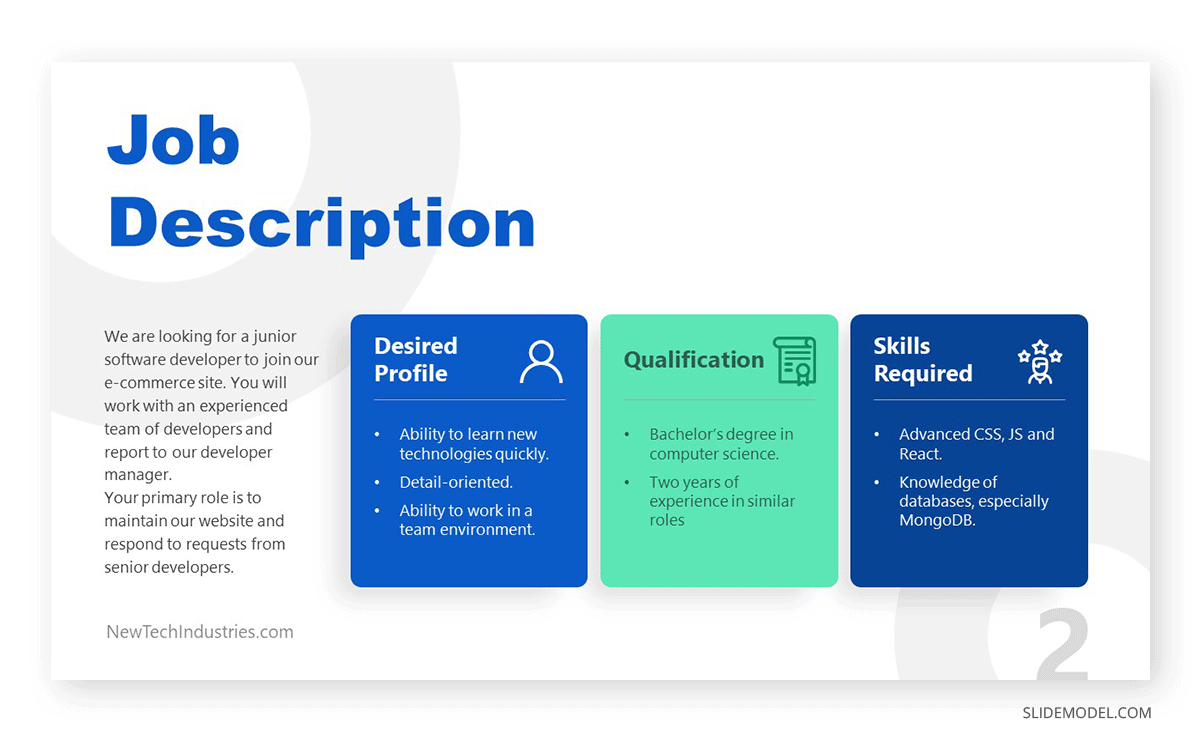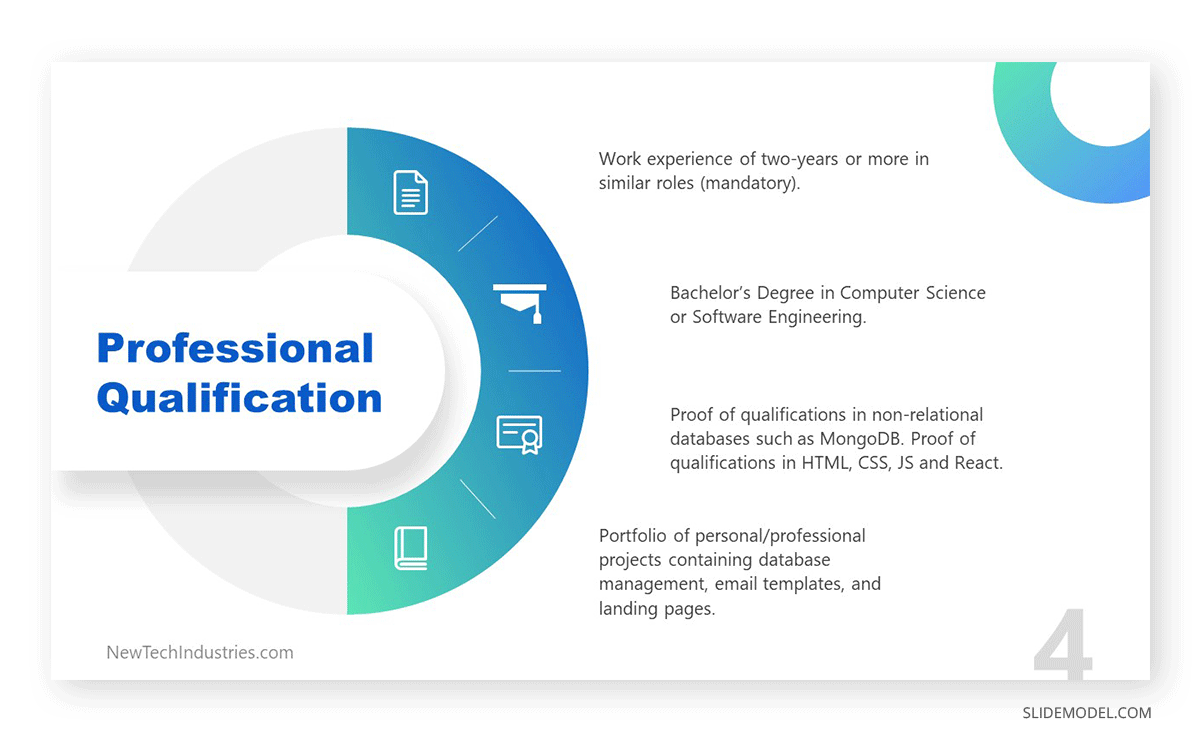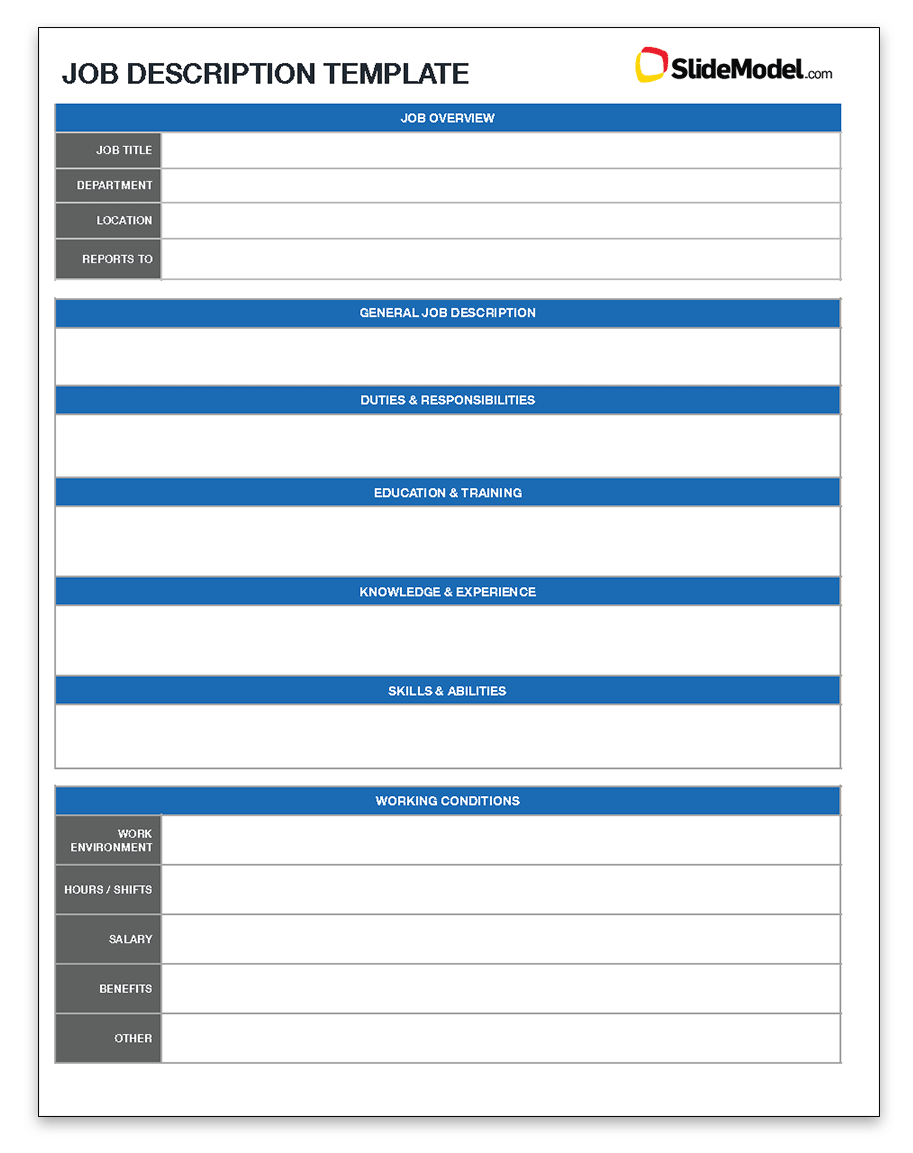
Recruiting new personnel can be a time-consuming process, especially for large corporations. A job description template is a tool used by HR teams to present a new vacancy to the market, but how exactly does it work?
In this guide, we will introduce what a job description template is, its value for both small and large corporations, and the key elements it must feature to attract the best talent available for the job posting. Let’s get started.
Table of Contents
- What is a Job Description
- Job Description vs. Job Advert
- Which Elements Should a Job Description Include
- Should you Include Salary in a Job Description
- How to Write a Job Description
- What is a Job Description Template
- Advantages of Using a Job Description Template
- Where to Post Your Job Offer
- Closing Thoughts
What is a Job Description
We can define a job description as a tool used by HR teams to describe the essential elements of a vacant job position, including essential skills, duties, responsibilities, and experience.
It is a document of vital importance for any HR department as it can clarify the tasks required from the employee, the success metrics, and any other relevant information that can be used internally and externally. Internal uses are in-company job postings – meaning those vacancies that don’t get publicly advertised – and also to evaluate any employee in terms of performance regarding the duties they were hired for. Externally, the job description serves as the base for a job posting that will be placed in a contact center.
Job Description vs. Job Advert
One commonly asked question is the difference between a job description and a job advert. As defined above, a job description is a document of internal usage for HR teams. It contains detailed information regarding the job to be filled and can serve as proof when employee disputes arise. The other important element in a job description is its value for the employee regarding which tasks are required, the responsibilities to manage, and some benchmarks to raise in a corporate career.
Instead, a job advert is a tool used by HR teams to attract potential employees to your company. Job adverts are the publications we often see on platforms such as LinkedIn, UpWork, and Fiverr or printed posts on ad walls. The format of job adverts forces them to be consumer-intended, meaning the copywriting for this kind of document won’t emphasize technical aspects but rather highlight the perks of working for such a company. Since acquiring talented human capital is fierce competition in some industries, HR teams often hire marketing professionals to review their job adverts, which ends up trimming much of the job description content in favor of clickbait.
Which Elements Should a Job Description Include
Job Title
This should be clear, specific, and without over-adjectivizing. The reason behind these requirements is that a job title is what the employee will refer to themself as, that being in-company or in other contexts such as legal paperwork required by financial institutions, business meetings, etc.
For example: “Jr. Software Developer,” “Financial Admin Assistant,” and “Sales Support Specialist.”
Manager
It is vital to clarify workplace hierarchies from the job description. The employee should know to whom they should report. Include a brief mention of the person who supervises the employee’s work, listing name, role in the company, and email.
Job Overview
This is what we usually see in job adverts; the text explains in simple words what the position is about, the company’s culture concerning the job vacancy, how the company considers success regarding this role, etc.
Make it brief, and remember this is part of the key data that an employee will refer to in case of any employee dispute. Between four to six sentences are the average length for this section.
Qualifications and Experience
This is where you can cull the audience to apply for the position. Typical points to the list are:
- Previous experience in similar roles (which can be mandatory)
- Educational background (depending on the role’s complexity, the higher qualifications you can ask)
- Certifications (courses, webinars, exams, etc., that prove the candidate’s aptitude to meet the requirements of the job)
- Soft skills
- Driver’s License/Machinery License (for positions within the construction industry, logistics, public transportation, aviation industry, etc.)
Do not neglect the importance of soft skills. For some recruiters, it can sound like unrequested data. Still, it can give insights into a candidate’s potential for teamwork – especially if working under pressure or with very tight deadlines is expected as a norm for that vacancy.
Should you Include Salary in a Job Description
This is a highly tricky point. Research conducted on LinkedIn concludes that there is a high risk of internal discrepancies when salary is disclosed in a job position. People who already work in a job position may feel undervalued when the disclosed salary for a vacancy in the same role offers a higher wage than the employee earns.
Other opinions go along the lines that disclosing salary information gives better tools to employees to negotiate for a better salary. On the other hand, companies could be forced to publish salary information in job postings according to a new law that affects some US states.
Salary information can discourage the common practice of job-hopping, where employees switch between jobs each 3-4 months, intending to increase their income with each move. The popular opinion on platforms such as LinkedIn is that employers should disclose the payment information, from wage to payment methods, to help candidates pick the best offer given their skills.
Undoubtedly controversial, we recommend you exclude the salary information in the job description as the document is expected to remain in-company. The employee’s salary shall naturally rise over time, which renders the initial value useless. Also, it can spike some jealousy between coworkers, so it’s best to discuss salary as a part of the initial interviews with a prospective candidate.
How to Write a Job Description Template
The process of writing a job description format is not complex, although it can be time-demanding. Let’s go step-by-step.
Step 1 – Job Title
Start your job description document by clearly stating a job title for the position. Since job titles also serve as keywords for job research, avoid these common mistakes:
- Explaining hierarchy in confusing terms. I.e., “Tier IV Software Architect.” Opt for well-known hierarchy terms such as Entry, Trainee, Junior, Semi-Senior, Senior, Lead, Manager, etc.
- Watch out for typos or grammar mistakes.
Shape the title to meet the main keyword relevant to the job search. For example, instead of “Architect in Software Solutions,” go for “Software Solutions Architect.”
Step 2 – Job Summary
This is the summary of the job proposal. It has to be clear, specific and mainly expose the points that identify a successful candidate to fill the position. Aim, on this point, to highlight the desired soft skills such as:
- Team-player
- Attentive to details
- Proactive
Those skills can be whichever skill is required to perform better in the position without falling into the technical skills required – that belongs to another section of this document.

It is also recommended to briefly describe what is expected from the employee after the first trial month and after 90 days (meaning after the trial period is over). Proofread this job overview with the rest of your HR team to see if any point is missing. Mentioning the manager who will supervise the role is also recommended.
Step 3 – Job Responsibilities
It helps a great deal to list down the main responsibilities associated with the role in the job description document. It can be done via bullet points, jotting down each item that’s exclusively associated with the role, not in general terms that apply to any other role. You can also work with Roles and Responsibilities Templates for PowerPoint if you want more detailed results on this topic.

Work shift and special time availability have to be listed on this point, as well as any key point in terms of the company’s conduct code (i.e., non-disclosure of the project details).
Step 4 – Qualifications and Experience
Make sure to highlight the importance of providing documents for accrediting the candidate’s educational background. If a university degree or similar is required, make the point relevant with the term “mandatory.”

Experience can be filled by showing the candidate’s CV, although it is recommended to ask for 2-3 professional references that can vouch for the candidate’s expertise and work ethic.

What is a Job Description Template
What if we tell you that most of the work related to building a job description template is already pre-made? A job description template is a PowerPoint or Google Slides file that contains an outline of the elements that are relevant to build a job description template.
Free Job Description Template

It saves valuable time in terms of design, and if you work with a file such as our Free Job Description Template, you can reuse this form as many times as required.
Advantages of Using a Job Description Template
Advantage #1 – It Saves Time
Since corporations often struggle to meet the deadline to release many job postings, job description templates help us save time by laying out the design of this document. Professional-looking graphics are a catchy element that drives the interest of any candidate. In careers related to design, it is mandatory to count on quality graphics on a document such as this one.
Advantage #2 – It is Reusable
Job description templates can come in many formats, and they are easy to reuse by just changing the content in text placeholders. These PPT templates can be tweaked to match the style of your branding by editing the color theme, font size, typeface, etc.
Advantage #3 – Standardized Document
Finally, job duties templates serve as a standard document by the HR department to easily retrieve information about any job post. Since all the forms meet the same style, HR teams can quickly check a required piece of information – for example, the duties and responsibilities associated with the job position – rather than going file by file and trying to search for that information.
Where to Post Your Job Offer
There are many places in which you can place your job post. The main place in which you should start is LinkedIn, and creating a job offer on LinkedIn requires the following points:
- Catchy graphics for the job offer.
- Written job description proposal, regardless if you place an image with the same information, such as your job description template. Search engines don’t analyze terms listed on images, hence the importance of writing them in the text area.
- Contact information to reach the recruiter.
- Perks that your company offers. In highly-competitive industries, this is a must.
UpWork is another valid option for placing a job offer. The format is different as you only get to write content instead of placing graphics (images can be attached to the job posting, but it is not secure that candidates shall download it). Be creative with copywriting to make your offer attractive, but ensure to include all the information required. Word of advice: UpWork doesn’t tolerate well the fact that freelancers and employers interact outside their platform. Don’t include any other methods of reaching out in the job description; that can be discussed via chat during the interview.
Consider placing your job offers on your company’s websites. It can be as easy as creating a page, or even a subdomain for it, say careers.yourdomainname.com. That’s a common practice done by large corporations, segmenting the traffic by not mixing job hunters with potential business conversions.
Closing Thoughts
As you can see, job description templates can help to speed up a common practice of HR departments. These editable files help in writing a job description as many times as required and can be easily distributed between your coworkers to check if any detail is missing.
We hope this guide brings more insight into the process of writing a job description and the value of job description templates. See you next time.


